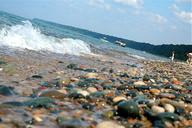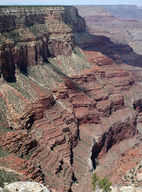4.10沉积岩
Section outline
-
Where can you go to see sediments?
::你去哪里看沉积物?Sediments are everywhere! One of the most fun places to see sediments is on a beach . Squishing sand between your toes is a great way to experience sediments firsthand (or foot).
::沉积物无处不在!看到沉积物最有趣的地方之一在海滩上。脚趾之间的沙子是体验沉积物的第一手(或脚)的好方法。Sedimentary Rocks
::沉积岩Most sedimentary form from sediments. The sediments must be packed together to form a rock. Sedimentary rocks also form as precipitate from saline water . Sedimentary rock formation is described in the next concept.
::大多数沉积形式来自沉积物,沉积物必须包装在一起形成岩石,沉积岩也是来自盐水的沉淀物,沉积岩的形成在下一个概念中有所描述。Sediments
::沉积物Sediments are fragments of rocks and minerals that can vary in size. Pebbles, sand, silt, and clay are examples of sediments. Sedimentary rocks may include fossils . Fossils are materials left behind by once-living organisms. Fossils can be pieces of the organism, like bones. They can also be traces of the organism, like footprints.
::沉积岩可能包括化石、化石、化石或化石。 化石可能是由曾经活过的生物留下的材料。 化石可以是有机体的碎片,如骨头。 它们也可以是有机体的痕迹,如脚印。Transport
::运输 运输Sediments are transported by water, wind , ice, or gravity. These agents move them from the place where they formed. The sediments are then deposited in a .
::沉积物通过水、风、冰或重力运输,这些物剂将沉积物从形成沉积物的地方移走,然后沉积在沉积物中。Deposition
::交存Sediments will eventually settle out of water ( Figure ). For example, rivers carry lots of sediment. Where the water slows, it dumps these sediments along its banks, into lakes or the ocean.
::沉积物最终会从水中沉淀(图 ) 。 例如, 河流中含有大量的沉积物。 当水缓慢时, 沉积物会沿着河岸、 湖泊或海洋倾倒。Cobbles, pebbles, and sands are the sediments that are seen on this beach. When sediments settle out of water, they form horizontal layers. A layer of sediment is deposited. Then the next layer is deposited on top of that layer. So each layer in a sedimentary rock is younger than the layer under it ( Figure ).
::当沉积从水中沉积时,沉积会形成水平层。沉积层会沉积。下一层沉积在该层之上。沉积岩中的每个层比下层小(图)。The rock layers at the Grand Canyon are horizontal. We know that layers at the bottom are older than layers at the top. Sediments are deposited in many different types of environments. Beaches and deserts collect large deposits of sand. Sediments also end up at the bottom of the ocean and in lakes, ponds , rivers, marshes , and swamps . Avalanches produce large piles of sediment. The environment where the sediments are deposited determines the type of sedimentary rock that can form.
::沉积物沉积在许多不同类型的环境中,海滩和沙漠收集大量沙子,沉积在海底和湖泊、池塘、河流、沼泽和沼泽中,雪崩产生大量的沉积物,沉积物沉积的环境决定了可形成沉积岩的类型。Summary
::摘要- Sediments are small fragments of minerals, rocks, or fossils.
::沉积物是矿物、岩石或化石的小块碎片。
- Sediments range in size from tiny bits of silt or clay to enormous boulders.
::沉积物大小不等,从淤泥或粘土的微小部分到巨石的巨石不等。
- Sediments are deposited in many different environments.
::沉积物沉积在许多不同的环境中。
Review
::回顾- What are sediments? What sizes are sediments?
::沉积物是什么?沉积物的大小是什么?
- What happens to sediments before they become a sedimentary rock?
::在沉积物变成沉积岩之前会怎样?
- What does the environment where sediments are deposited mean for the rock that eventually forms?
::对于最终形成的岩石而言,沉积沉积物的环境意味着什么?
- Sediments are small fragments of minerals, rocks, or fossils.


